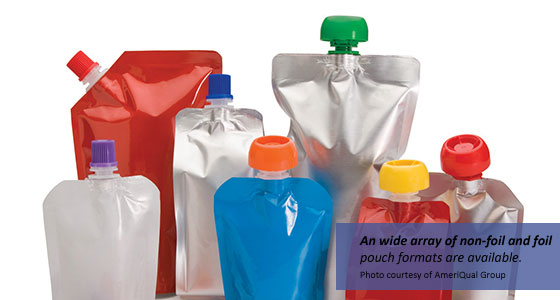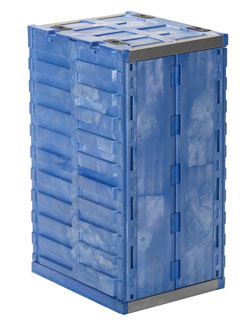Poster Presenters Focus on Packaging’s Future: Active, Edible, Bio-Based, and Holistic
Packaging Preview

The future is now and tomorrow for food packaging technology—to buttress food preservation and delivery. Within the 2013 IFT Annual Meeting’s Scientific Program, active packaging is the packaging topic that will receive the greatest attention. Read on for a preview of some of the presentations that are scheduled.
Modified Atmosphere Preservation and Packaging
Developed more than 60 years ago, modified atmosphere packaging (MAP) has grown into one of the largest-volume food technologies, but suffers from limited scientific bases. Among the more misunderstood elements is the need for reduced temperature for functionality. IFT’s Food Packaging Division has not yet organized a program beyond the empirical, but valuable applications information is scattered throughout this Annual Meeting, largely in poster sessions, which will take place in the Food Expo exhibit hall.
Christine Boisrobert of Air Liquide will present on the topic “The Effect of Packaging Gas and Chill Rate on the Quality Life of Chilled and Frozen Foods” in session 004-03, at 7:55 a.m. Sunday, July 14, in room S501cd. How appropriate that Boisrobert’s Bastille Day holiday is celebrated as she opens with a review of the essential interplay of internal environment and packaging.
In poster session 034-35 at noon Sunday, July 14, H. Gartner will discuss “The Effects of Packaging Gas Compositions and Materials on the Sensory Quality of Fresh-Cut Celery.” Modified atmosphere packaging of fresh-cut celery with polyester film coated with aluminum oxide and polylactic acid demonstrate that the latter package structure delivers up to two weeks of chilled shelf life.
M. Rangel-Marron will present on “Alginate-Based Edible Coating and Modified Atmosphere Packaging to Extend Shelf Life of Fresh-Cut Mango” in poster session 035-33 at noon Sunday, July 14. In this research project, the alginate-containing glycerol film coupled with MAP to inhibit growth of mold on fresh-cut mangoes.
The topic for poster session 035-17 at noon Sunday, July 14, is “Shelf Life Extension of Fresh Sweet Cherries Using a Microperforated Biodegradable Packaging System.” E. Almenar will be reporting on the use of MAP to extend chilled shelf life of sweet cherries.
“Impacts of Modified Atmosphere Packaging on Bioactives of Organic Chinese Red Raspberry Fruit During Postharvest Refrigerated Storage” is the topic for poster session 217-02 at 2:30 p.m. Monday, July 15. The packaging that will be under discussion by presenter W. Lu is vented half-pint trays overwrapped in plastic films with differing gas permeabilities.
Antimicrobial Packaging
Incorporating active antimicrobial materials into food packaging has offered the promise of extending shelf life, but has been limited by adverse secondary effects, legal questions, costs, and actual effectiveness. While industry research has been scant, most information on this topic has come from universities—especially offshore. The 2013 presentations are largely poster sessions dealing with updates on natural chemicals (e.g., essential oils). Somewhat new this year is the marriage of bio-based package materials with antimicrobials.
In poster session 34-01 at noon on Sunday, July 14, R. Avena-Bustillos will discuss “Antibacterial Activity and Physical Properties of Açai Edible Films with Thyme Essential Oil and Apple Skin Polyphenol.” The açai berry has excellent antioxidant properties due to its anthocyanin content. By combining edible açai film with thyme and apple skin polyphenol, the researchers enhanced antimicrobial activity.
The topic for S. Hong in session 034-07 at noon Sunday, July 14, is “Preparation and Characterization of Antimicrobial Agar/Silver Nanoparticles Composite Films.” In this research project, silver nanoparticles up to 1% by weight in an agar matrix were cast to produce films with microbicidal properties, particularly against Listeria and E.coli O157:H7 organisms.
Poster session 34-08 at noon on Sunday, July 14, will focus on research by S. Kwon; the presentation is titled “Development of an Antimicrobial Packaging Material Using a Microencapsulated Essential Oil with Polyvinyl Alcohol.” Vapor generated from 18 microencapsulated essential oils incorporated into polyvinyl alcohol film demonstrated antimicrobial activity on contaminated iceberg lettuce in this study.
In poster session 034-28 at noon on Sunday, July 14, R. Cruz will address the topic “The Impact of Chitosan Packaging Films on Physiochemical Properties of Refrigerated Salmon.” For this project, active packaging films were constructed of chitosan plus grape seed extract and carvacrol to extend quality retention of chilled salmon.
E. Almenar will discuss “Active Packaging of Cheese with Bioplastics Based on Wheat Proteins and Natural Antibiotics” at noon Sunday, July 14, in poster session 034-29. Wheat gluten was combined with cinnamaldehyde and natamycin to form a “natural” active package material to help control mold growth on cheese surfaces.
In poster session 260-02 at 10 a.m. on Tuesday, July 16, C. Gurdian Curran will discuss “Development of an Antimicrobial Whey Protein Isolate Film with Oregano Essential Oils to Improve Shelf Life of Cheeses at Refrigerated Storage Conditions.”
In poster session 035-20 at noon on Sunday, July 14, the topic for G. Peretto will be “Increasing Strawberry Shelf Life with Carvacrol and Methyl Cinnamate Antimicrobial Vapors Released from Edible Films.” When methyl cinnamate was combined with carvacrol, surface mold was suppressed for up to three days under chilled conditions in this study.
“Development of Active and Nanotechnology-Based Intelligent Edible Packaging Systems: Physical-Chemical Characterization” will be the subject at noon Sunday, July 14, in poster session 034-30 by A. Vincente. For this study, natamycin was incorporated into edible polysaccharide films with and without hydrogels to inhibit migration of moisture, oxygen, and carbon dioxide in fresh-cut produce, cheese, fruit, and fish.
In poster session 034-33 at noon Sunday, July 14, J. Shin will discuss “Active Packaging: Surface Modification Using UV for Attachment of Natamycin to Polystyrene.” UV radiation was used to generate reactive functional groups to attach natamycin to the surface of polystyrene to control microorganisms.
In poster session 034-17 at noon Sunday, July 14, Z.T. Jin will share insights on “Antimicrobial Efficacy of Packaging Films and Direct Coatings against Listeria innocus on Deli Turkey Meat.” Antimicrobials such as chitosan and lauric polylactic acid and/or nisin on package materials were combined with steam flash pasteurization to achieve up to five log reduction in Listeria for ready-to-eat meats.
Bacteriophages were encapsulated and integrated with edible coatings to form specific antimicrobials to achieve two log reductions in target microorganisms including pathogens for a research project that will be discussed by E. Vonasek at noon Sunday, July 14, in poster session 034-32. It is titled “Integrating Bacteriophages and Active Packaging for Antimicrobial Coatings.”
At noon Sunday, July 14, in poster session 034-13, X. Sun will discuss “Incorporation of Gallic Acid Improves Antimicrobial Activity and Mechanical Properties of Chitosan Films.” These studies demonstrated that the antimicrobial activity of chitosan could be significantly increased by homogeneously dispersing up to 1.5% gallic acid; water vapor and oxygen permeability were also improved.
“Developing Functional Bio-Plastic Films from Biomass and Biopolymer Composites” will be explored in poster session 034-09 at noon Sunday, July 14, by S. Shin. Films were developed using fruit peel residues as raw materials. The films were enhanced by incorporation of organic acids as antimicrobials and nanoclays.
--- PAGE BREAK ---
On Monday, July 15, at 1:55 p.m. in symposium session 183-02 in room S404abc, Tom Dunn will present on the topic “Natural Chemistry for Active Packaging.” Substitution of natural active compounds such as essential oils to achieve functionality is intended to satisfy those who are concerned that “synthetics” would be contaminants in foods in contact with the package structures. This promises to be one of the most important papers of the 2013 Scientific Program. It will discuss actuating natural materials as active antimicrobials and antioxidants that until now have not been able to resist elevated processing temperatures.
In the same symposium (session 183-01) on Monday, C.N. Cutter will discuss “Antimicrobial Packaging for Meat and Poultry Products: Sustainability and Regulatory Considerations.” This will be one of the few verbal sessions dealing with issues in active packaging. It will begin at 1:35 p.m.
Kay Cooksey will discuss “Comparison of Methods Used for Testing Antimicrobial Packaging Films” in poster session 034-38 at noon Sunday, July 14. Commercialization of antimicrobial packaging films has been a challenge because of legal and liability issues, cost, sensory side effects, and production capabilities. Implementation also is hindered by variation in efficacy due to widely varying screening and testing methods. In this presentation, issues will be detailed to suggest alternatives.
Antioxidant Packaging
This year, several researchers are reporting on the adverse effects of oxidation and suggesting means to overcome them through active packaging.
In poster session 034-10 at noon Saturday, July 14, H. Jo will discuss “Development of Antioxidant Packaging Material by Applying Corn Zein to LLDPE Film in Combination with Phenolic Compounds.” Although much of the focus of active packaging has been on antimicrobials, foods also deteriorate by oxidations that may be in part controlled by antioxidants incorporated into the package structure. Multilayer films made of linear low-density polyethylene films plus corn zein were fabricated with essential oils’ naturally containing antioxidants. The phenolics were released from and migrated from the essential oils into ground beef. Color stability and lipid oxidation were effectively controlled by the additives.
“Preventing Oxidation of Bioactive Compounds via Chelating Active Packaging: Influence of Surface Chemistry” is the topic in poster session 034-14 to be presented by J. Goddard at noon Sunday, July 14. To counter the effects of iron contaminants as oxidation stimulators, chelating agents were incorporated onto surfaces of films. Because covalent modification was applied, chelators are unlikely to migrate into the food.
In poster session 034-21 at noon Sunday, July 14, F. Tian will discuss “Control of Lipid Oxidation by a Non-migratory Active Package Prepared by Surface Grafting of a Biomimetic Chelator,” offering more insight on the application of chelators to obviate the effects of iron salts as oxidation accelerators.
Ethylene Control
Climacteric fruit emits ethylene, whose suppression extends chilled shelf life. Sachets containing potassium permanganate have been employed in distribution to control ethylene. Many inert minerals have been claimed to reduce ethylene, but results have been questionable.
In poster session 034-24 at noon Sunday, July 14, W. Yu will discuss “Formation of PLA Package for Controlled Release of 1-MCP.” 1-methylcyclopropene (1-MCP) is a competitive ethylene inhibitor capable of delaying ripening of climacteric produce. 1-MCP was immobilized on polylactic acid film for controlled release to retard ripening and extend shelf life.
Integration of Packaging and Processing
Not all packaging presentations will deal with active packaging; too few of those scheduled will address processing, extended shelf life, and sustainability.
In poster session 215-03 at 2:30 p.m. Monday, July 15, H. Caulfield will discuss “Development of Continuous Processing Method for Pouches in Rotary Retorts,” offering a comparison of methods for using existing commercial rotary retorts for processing foodservice retort pouches and No. 10 cans of green beans.
In a symposium presentation (session 181-03) at 2:15 p.m. Monday, July 15, in room S505 Juming Tang will discuss “915 MHz Microwave Technologies for Commercial Production of Safe Foods.” He will offer an updated review of the application of microwave assisted sterilization and pasteurization of barrier packaged foods to deliver ambient temperature shelf-stable and extended chilled shelf-life prepared foods.
In poster session 032-04 at noon Sunday, July 14, A.H. Barrett will present “Stabilized Food for Use in Extended Spaceflight: Preservation of Shelf Life, Nutrient Content and Acceptability.” The presentation will provide an update of developments of microbiologically safe high quality foods for fiveyear shelf life (i.e., space voyages to and from Mars using both retort sterilized and non-retorted foods).
A Future for Food Packaging
It is evident that food packaging did not receive major inputs for this year’s Scientific Program. Advances are rapid and profound in food packaging, but most of the presentations for the Annual Meeting are on active packaging. Reasons for the trend away from commercial interest are discussed on the program.
A shift in priorities away from the intense focus on active packaging and sustainability and toward technologies that advance safety, quality retention, distribution control, and convenience is urged here.
Exhibitor Information
The following are brief descriptions of some of the packaging-related supplier exhibits at this year’s Food Expo.
 • Patent-pending, collapsible 60-gal plastic drum has a smaller footprint and greater capacity than alternative products, offering 25% better cube utilization than a standard 55-gal drum. Its base, sidewalls, and lid are designed with offset surfaces and interlocking flanges so that there are no cracks in the joints, minimizing the threat of contamination. Smooth inside and outside sidewall surfaces promote ease of cleaning. The sidewalls are hinged in the center for a one-way inward fold, which means the drum can be folded flat in seconds. Buckhorn, www.buckhorninc.com, Booth 3605
• Patent-pending, collapsible 60-gal plastic drum has a smaller footprint and greater capacity than alternative products, offering 25% better cube utilization than a standard 55-gal drum. Its base, sidewalls, and lid are designed with offset surfaces and interlocking flanges so that there are no cracks in the joints, minimizing the threat of contamination. Smooth inside and outside sidewall surfaces promote ease of cleaning. The sidewalls are hinged in the center for a one-way inward fold, which means the drum can be folded flat in seconds. Buckhorn, www.buckhorninc.com, Booth 3605
• A specialist in production, packaging, assembly, and distribution of shelf-stable and portion-controlled foods, AmeriQual has capabilities that now include shelf-stable hot fill and retort spouted pouches. The company processes high- and low-acid foods and beverages in varied non-foil and foil spouted pouch formats for product categories including baby food, beverages, condiments, fruit and vegetable purees, juices, sauces, spreads, syrups, yogurt blends, and more. AmeriQual Group, www.ameriqual.com, Booth 3300
• Food Packaging: Principles and Practice, Third Edition, is a reference for students and professionals. Amply illustrated and with more than 1,000 references, the book covers the packaging requirements of the major food groups. It provides up-to-date information on active packaging technologies, offers guidance on the design and analysis of shelf-life experiments, and wraps up with a chapter on sustainable food packaging. Taylor & Francis Group, www.tandfonline.com, Booth 2040
 Aaron L. Brody,
Aaron L. Brody,
Ph.D., CFS, Contributing Editor
President and CEO, Packaging/Brody Inc., Duluth, Ga., and Adjunct Professor, University of Georgia
[email protected]
